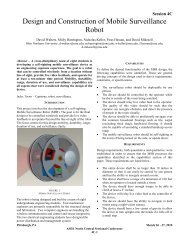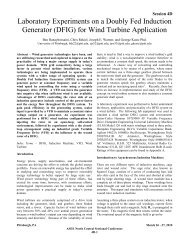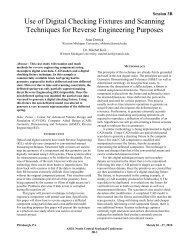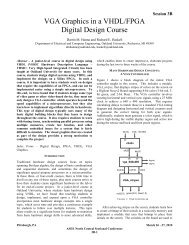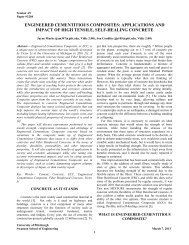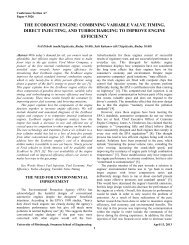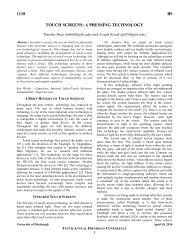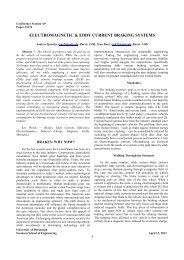You also want an ePaper? Increase the reach of your titles
YUMPU automatically turns print PDFs into web optimized ePapers that Google loves.
off. Companies have switched to a digital control system,<br />
giving them the ability to control multiple processes at the<br />
same time. These central computers provide companies with<br />
the ability to utilize more than one factor in computation<br />
than just one like an older system. Aspects such as heating<br />
and cooling systems, ventilation systems, lighting, etc. can<br />
all be constantly monitored to find the most economical<br />
setting that the company is looking for. By implementing<br />
faster control in smaller spaces, multiple apparatuses do not<br />
have to be implemented into control processes, saving<br />
energy [23].<br />
The faster these control systems are, the more complex<br />
information these systems can have. Their ability to<br />
determine the most efficient solution at a fast pace to<br />
problems given will save time, money and resourses. This<br />
will also help to reduce the large amount of waste disposal<br />
some manufacturing processes posses [23]. Improving the<br />
speed of control will improve human life and save mass<br />
amounts of energy.<br />
Control systems have allowed for reduced waste and<br />
resources in manufacturing processes and thermal control in<br />
buildings, but the control systems themselves are also<br />
representing a reduction in waste. Figure 2 illustrates one of<br />
the first control systems used for controlling an engine’s<br />
speed, which was replaced by a small computer chip.<br />
Changes such as this from analog to digital have made<br />
products more environmentally friendly as they use less<br />
material for their internal systems. This is an oftenoverlooked<br />
benefit of these modern control systems.<br />
POSSIBILITIES FOR THE FUTURE<br />
The control system is an extremely powerful device, giving<br />
users the ability to manipulate robots and make them do<br />
what they want. Through the addition of advanced sensors<br />
giving control systems vital information for making<br />
decisions, robots are able to have legs. With legs, robots like<br />
BigDog have much greater mobility than any robot we have<br />
ever seen before, traveling up slopes, over ice, and through<br />
tough terrain. These advanced sensors and appendages<br />
combined with more powerful computer hardware and<br />
software will make robots of the future more capable,<br />
reliable, and autonomous than ever. Robots like BigDog<br />
show that we are close to having mobile robots that can<br />
handle some of the toughest terrain and recover from slips<br />
and falls without any human intervention, indicating how<br />
close we are to achieving the ultimate science fiction goal:<br />
having a C3PO or iRobot that is capable of inputting<br />
environment data and acting accordingly.<br />
REFERENCES<br />
[1] J. Fulcher L. C. Jain. (2004). Applied Intelligent Systems. Berlin,<br />
Germany: Springer-Verlag.<br />
Paper 1018<br />
[2] C. W. deSilva. (1989). Control Sensors and Actuators. Englewood<br />
Cliffs, NJ: Prentice Hall.<br />
[3]http://upload.wikimedia.org/wikipedia/commons/1/1e/Centrifugal_gover<br />
nor.png<br />
[4] J. Maxwell. (1868). “On Governors”. Proceedings of the Royal Society.<br />
No. 100 p. 1.<br />
[5] K. J. Astrom and R. M. Murray. (2008). Feedback Systems. Princeton,<br />
NJ: Princeton University Press.<br />
[6] Patent: Wisner, D. A. (1968). U.S. Patent No. 3,511,329. Washington,<br />
DC: U.S. Patent and Trademark Office.<br />
[7] C. Phillips, T. Nagle. (1990). “Digital Control: System Analysis and<br />
Design‖. Englewood Cliffs, NJ: Prentice Hall.<br />
[8] B. Barraclough K. Dutton S. Thompson. (1997). The Art of Control<br />
Engineering. Harlow, England: Addison-Wesley.<br />
[9] J. L. Fuller. (1999). Robotics: Introduction, Programming, and<br />
Projects. Upper Saddle River, NJ: Prentice Hall.<br />
[10] S. R. Ruocco. (1987). “Robot Sensors and Transducers‖. New York-<br />
Toronto: Halsted Press.<br />
[11] “iPhone 4: Technical Specs”. Apple. [Online]. Available:<br />
http://www.apple.com/iphone/specs.html<br />
[12] A. C. Staugaard, Jr. (1987). Robotics and AI. Englewood Cliffs, NJ:<br />
Prentice Hall.<br />
[13] (1987, April). “Voyager-The Flying Computer Center”. NASA.<br />
[Online]. Available: http://history.nasa.gov/computers/Ch6-2.html<br />
[14] (2011, February 25). “Frequently Asked Questions”. Jet Propulsion<br />
Laboratory. [Online]. Available: http://voyager.jpl.nasa.gov/faq.html<br />
[15] M. Bajracharya, M.Maimone, D. Helmick. (2008, December).<br />
“Autonomy for Mars Rovers: Past, Present, and Future”. Computer Vol. 41<br />
No. 12 p. 45.<br />
[16] C. Cook. (2010, June 28). “Voyager 2 at 12,000 Days: The Super-<br />
Marathon Continues”. NASA. [Online]. Available:<br />
http://www.nasa.gov/mission_pages/voyager/voyager20100628.html<br />
[17] C. Cook. (2010, May 24). “Engineers Diagnosing Voyager 2 Data<br />
System—Update”. Jet Propulsion Laboratory. [Online]. Available:<br />
http://www.jpl.nasa.gov/news/news.cfm?release=2010-151<br />
[18] M. Raibert. (1986). “Legged Robots That Balance‖. Cambridge,<br />
Massachusetts: MIT Press.<br />
[19]http://upload.wikimedia.org/wikipedia/commons/1/10/Dragons_Teeth_<br />
at_Waverley_Abbey.JPG<br />
[20] “What Powers Watson?” IBM. [Online]. Available: http://www-<br />
03.ibm.com/innovation/us/watson/watson-for-a-smarter-planet/watsonschematic.html<br />
[21] M. Raibert, K. Blankespoor, G. Nelson, R. Playter, and the BigDog<br />
Team. (2008, April 8). “BigDog, the Rough-Terrain Quadruped Robot.”<br />
Boston Dynamics. [Online]. Available:<br />
http://www.bostondynamics.com/bd_index.html<br />
[22] Boston Dynamics. (2008). BigDog Powerpoint Slides. [Online].<br />
Available: http://www.bostondynamics.com/bd_index.html<br />
[23] Pierce, Julia. (2007, Aug. 13). “Sweet Solutions”. Engineer . Vol. 293<br />
Issue 7730, p46-48<br />
ACKNOWLEDGEMENTS<br />
We would like to thank our parents for inspiring our interest<br />
in the field of robotics. Also, we would like to thank our<br />
session co-chair Caitlin Magley and session chair Greg<br />
Wunderley for supporting us during the research process.<br />
University of Pittsburgh Swanson School of Engineering<br />
Eleventh Annual Freshman Conference April 9, 2011<br />
8




